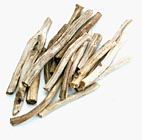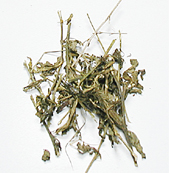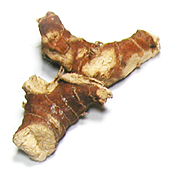




It is known as the Indian 'Female Rejuvenative' Asparagus is helpful for low sex drive, menopause, PMS and infertility. It is an herb that is commonly used in Ayurvedic medicine. One of the well-known major therapeutic potentials of Asparagus racemosus (Shatavari) is its effect on female reproductive system. The plant has been used in ayurveda to increase milk secretion during lactation. It is also used as general tonic, and as an aphrodisiac. Asparagus recemosus (Shatavari) is recommended in Ayurvedic texts for prevention and treatment of gastric ulcers, dyspepsia and as a galactogogue. Asparagus racemosus has also been used successfully by some Ayurvedic practitioners for nervous disorders, inflammation, liver diseases and certain infectious diseases. However, no scientific proof justifying aforementioned uses of root extract of Asparagus racemosus is available so far. Recently few reports are available demonstrating beneficial effects of alcoholic and water extracts of the root of A. racemosus in some clinical conditions and experimentally induced diseases, e.g. galactogogue effect, antihepatotoxic and immunomodulatory activities..

Achyranthes aspera is widely used in the treatment of a range of complaints. Ophthalmic. Achyranthes aspera whole plant is used medicinally, but the roots are generally considered to be more effective. Achyranthes aspera roots contain triterpenoid saponins. Achyranthes aspera root is astringent, diuretic and antispasmodic. Achyranthes aspera is used in the treatment of dropsy, rheumatism, stomach problems, cholera, skin diseases and rabies. Achyranthes aspera juice extracted from the root of this plant, mixed with the root of Urena lobata and the bark of Psidium guajava, is used in the treatment of diarrhea and dysentery. Achyranthes aspera plant is astringent, digestive, diuretic, laxative, purgative and stomachic. Achyranthes aspera juice of the plant is used in the treatment of boils, diarrhea, dysentery, hemorrhoids, rheumatic pains, itches and skin eruptions. The ash from the burnt plant, often mixed with mustard oil and a pinch of salt, is used as a tooth powder for cleaning teeth. It is believed to relieve pyorrhea and toothache. The leaf is emetic and a decoction is used in the treatment of diarrhea and dysentery. A paste of the leaves is applied in the treatment of rabies, nervous disorders, hysteria, insect and snake bites.

Aegle marmelos fresh ripe pulp of the higher quality cultivars, and the "sherbet" made from it, are taken for their mild laxative, tonic and digestive effects. A decoction of the unripe fruit, with fennel and ginger, is prescribed in cases of hemorrhoids. Aegle marmelos has been surmised that the psoralen in the pulp increases tolerance of sunlight and aids in the maintaining of normal skin color. Aegle marmelos is employed in the treatment of leucoderma. Marmelosin derived from the pulp is given as a laxative and diuretic. For medicinal use, the young fruits, while still tender, are commonly sliced horizontally and sun-dried and sold in local markets. Aegle marmelos are much used ino Malaya and Europe because of the astringency, especially of the wild fruits, the unripe bael is most prized as a means of halting diarrhea and dysentery, which are prevalent in India in the summer months. Aegle Marmelos(Bael) fruit was resorted to by the Portuguese in the East Indies in the 1500's and by the British colonials in later times. A bitter, light-yellow oil extracted from the seeds is given in 1.5g doses as a purgative. Aegle marmelos bitter, pungent leaf juice, mixed with honey, is given to allay catarrh and fever. With black pepper added, it is taken to relieve jaundice and constipation accompanied by edema. Aegle marmelos leaf decoction is said to alleviate asthma. A hot poultice of the leaves is considered an effective treatment for ophthahnia and various inflammations, also febrile delirium and acute bronchitis.Aegle marmelos decoction of the flowers is used as eye lotion and given as an antiemetic. Aegle marmelos bark decoction is administered in cases of malaria. Decoctions of the root are taken to relieve palpitation of the heart, indigestion and bowel inflammations; also to overcome vomiting. Aegle marmelos fruit, roots and leaves have antibiotic activity. Aegle marmelos root leaves and bark are used in treating snakebite.

In most South East Asian countries dried galanga is employed only in the absence of fresh galangal whereas in Indonesia slices or powder of the fresh or dried rhizome are used frequently. Alpania galanga rhizome is used against rheumatism, bronchial catarrh, bad breath, and ulcers whooping colds in children, throat infections, to control incontinence, fever and dyspepsia. Alpania galanga root has been used in Europe as a spice for over a thousand years, having probably been introduced by Arabian or Greek physicians, but it has now largely gone out of use except in Russia and India. Alpania galanga rhizomes have been used as flavours in native dishes and ingredients in many traditional medicines to treat various ailments, such as stomach disorders and skin diseases. In India the (Alpania galangal) rhizomes have many applications in traditional medicines such as for skin diseases, indigestion, colic, dysentery, enlarged spleen, respiratory diseases, mouth and stomach cancer. Alpania galanga Rhizomes show anti-bacterial, anti-fungal, anti-protozoal, and expectorant activities. Alpania galangal is used as a body deodorizer and halitosis remedy..
